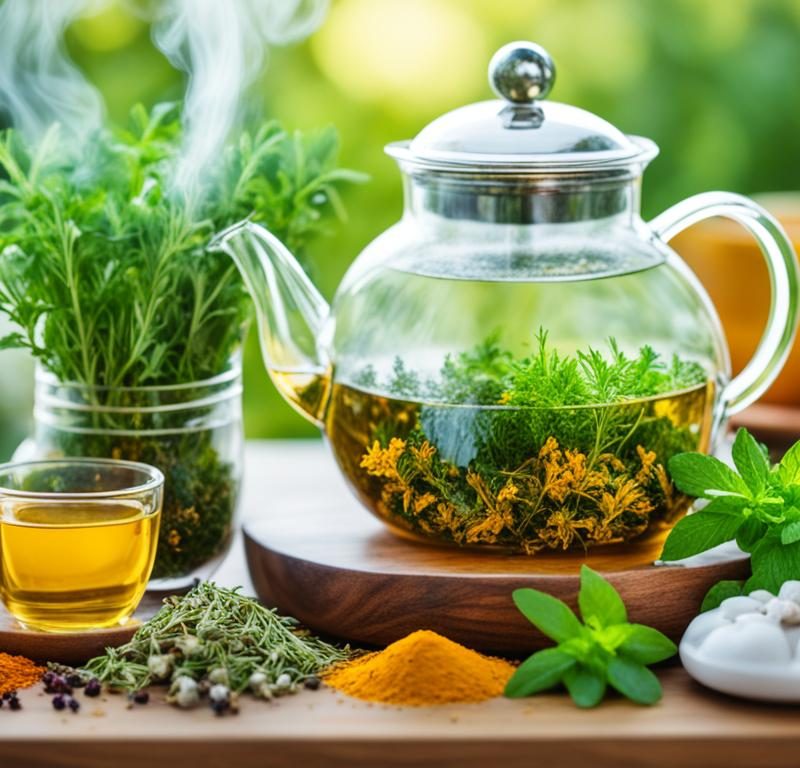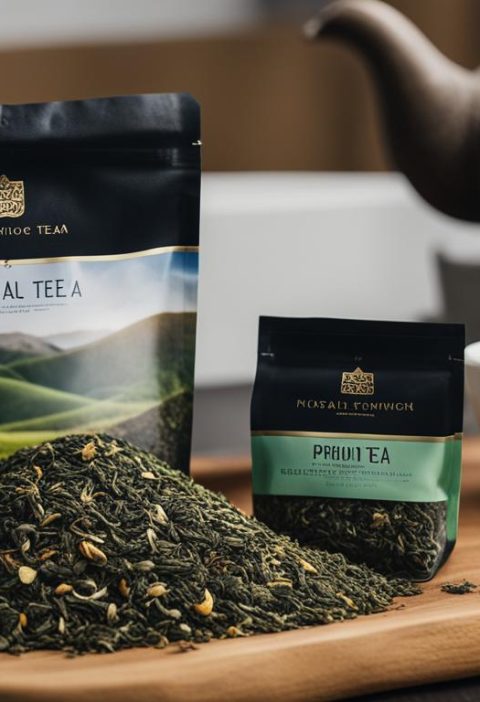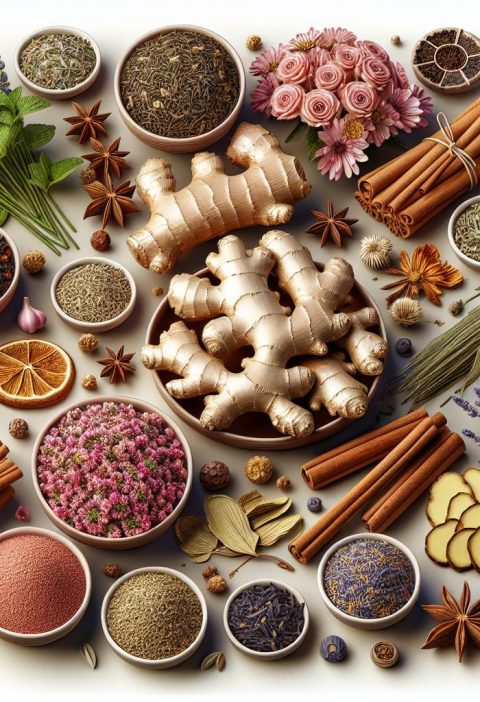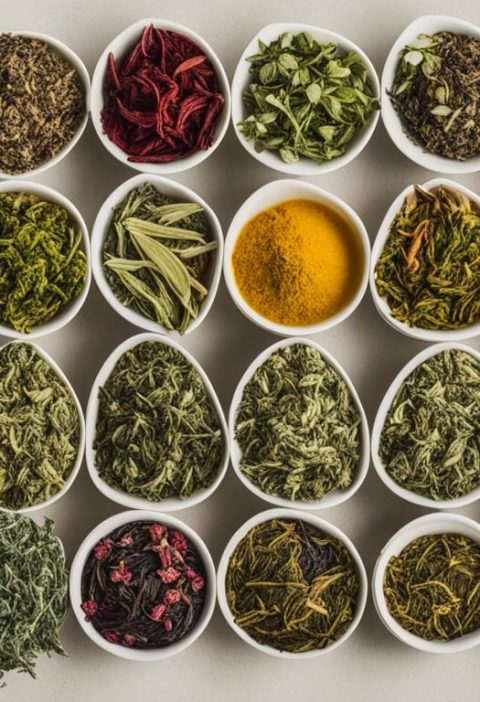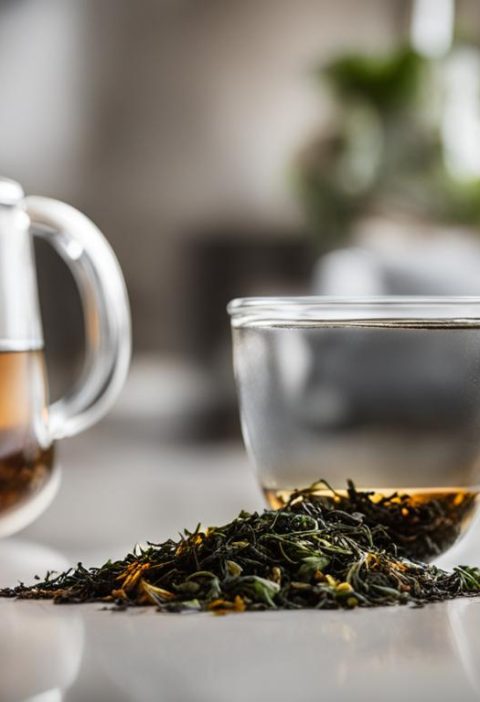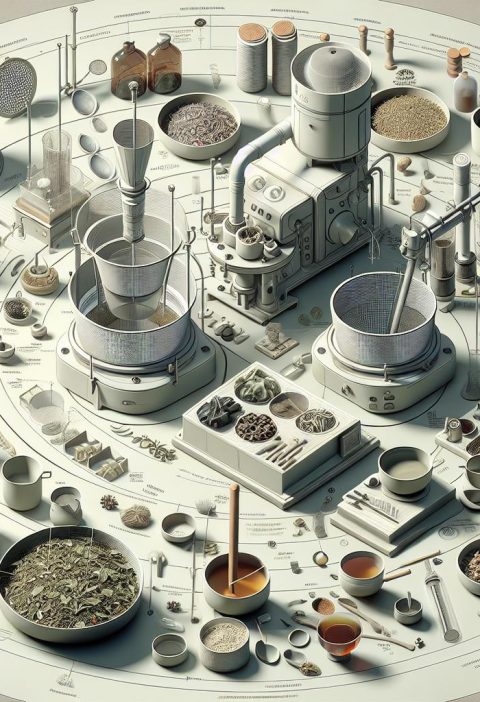A delicious cup of tea can chase away the winter chill, recharge you during the day, or relax you at night. To brew tea, you steep it in hot water. Steeping is the process of extracting the flavor and health-promoting compounds from the solids used to make tea.
True Tea vs. Herbal Tea
True teas come from the Camellia sinensis plant and include black, green, oolong, and white tea. They have different flavors, colors, and antioxidant contents depending on the oxidation process. Herbal teas, also known as tisanes, are made from the roots, leaves, stems, or flowers of other herbs and plants, such as hibiscus, peppermint, chamomile, or ginger. The steeping techniques and proportions vary for each type.
Key Takeaways:
- True tea includes black, green, oolong, and white tea, while herbal tea refers to teas made from other herbs and plants.
- Each type of tea requires different steeping techniques and proportions.
- True teas have different flavors, colors, and antioxidant contents based on the oxidation process.
Fresh vs. Dried Ingredients
The basic steeping technique is the same for both fresh and dried ingredients, but the amounts needed to brew a cup may vary. Fresh ingredients should be used shortly after cutting or purchasing, while dried tea leaves have a longer shelf life when stored properly. The steeping time and water temperature needed to extract the best flavors can also differ.
Key Takeaways:
- Both fresh and dried ingredients can be used for tea steeping.
- Fresh ingredients should be used shortly after cutting or purchasing for optimal flavor.
- Dried tea leaves can be stored for a longer period.
- Steeping time and water temperature may vary for fresh and dried ingredients.
Time and Temperature for Steeping Tea
The optimal steeping time and water temperature for different types of tea can vary. Green tea should be steeped for 3-4 minutes at 175°F, while black tea requires 3-4 minutes at 195°F. Steeping tea for too long or at too high a temperature can result in a bitter taste and increased caffeine content. It is important to find the right balance for each variety.
Key Takeaways:
- Steeping time and water temperature vary based on the type of tea.
- Green tea should be steeped at 175°F for 3-4 minutes.
- Black tea requires a water temperature of 195°F for 3-4 minutes.
- Oversteeping or using too high a temperature can result in bitterness and increased caffeine content.
Hot vs. Cold Steeping
Hot steeping is the quicker method for brewing tea, taking up to 5 minutes. Cold steeping, on the other hand, takes up to 12 hours but results in a smoother tasting tea with higher antioxidant content. Cold steeping at lower temperatures for a longer time can help retain more polyphenols. Both methods have their benefits and can be chosen based on preference and time availability.
Key Takeaways:
- Hot steeping takes less time, while cold steeping requires longer infusion.
- Cold steeping results in a smoother tasting tea with higher antioxidant content.
- Lower temperatures and longer infusion times can help retain more polyphenols during cold steeping.
- Choose the method based on personal preference and time availability.
True Tea vs. Herbal Tea
When it comes to tea, there are two main categories: true tea and herbal tea. True teas, also known as pure teas, are derived from the leaves of the Camellia sinensis plant. These teas include black, green, oolong, and white tea, each with its own distinct characteristics and health benefits.
On the other hand, herbal teas, also known as tisanes, are not derived from the Camellia sinensis plant. Instead, they are made from the roots, leaves, stems, or flowers of various herbs and plants such as hibiscus, peppermint, chamomile, or ginger. These herbal tea varieties offer a wide range of flavors and aromas.
Let’s take a closer look at the differences between true teas and herbal teas:
True Tea
| Tea Type | Flavor | Color | Antioxidant Content |
|---|---|---|---|
| Black Tea | Strong, robust | Dark amber to reddish-brown | High |
| Green Tea | Grassy, vegetal | Pale green to golden | Medium to high |
| Oolong Tea | Floral, fruity | Light to medium brown | Medium to high |
| White Tea | Mild, delicate | Light yellow to pale amber | Low to medium |
Herbal Tea
Herbal teas offer a diverse range of flavors and aromas, as they are crafted from various herbs and plants. Here are some popular herbal tea varieties:
- Hibiscus tea: Known for its tart and tangy flavor.
- Peppermint tea: Refreshing and soothing, with a cooling menthol taste.
- Chamomile tea: Mild and calming, often used for relaxation and sleep.
- Ginger tea: Spicy and invigorating, with a hint of warmth.
The steeping techniques and proportions for true teas and herbal teas can vary. True teas are typically steeped in hot water, while herbal teas may require different steeping times and temperatures based on the specific herb or plant used.
Now that we have explored the differences between true teas and herbal teas, we can better appreciate the variety and richness of the tea world. Whether you prefer the bold flavors of black tea or the soothing qualities of herbal infusions, there is a tea out there for everyone.
Fresh vs. Dried Ingredients
When it comes to steeping tea, the choice between fresh and dried ingredients can impact both the flavor and brewing process.
Fresh ingredients are known for their vibrant flavors and aromatic qualities. They are usually used shortly after cutting or purchasing to ensure optimal taste. Fresh tea leaves can provide a refreshing and invigorating experience, especially when brewing herbal teas like peppermint or chamomile.
Dried ingredients offer a convenient option and have a longer shelf life when stored properly. Dried tea leaves can be easily stored and used whenever you are in the mood for a cup of tea. They provide a more concentrated flavor profile and are commonly used in the steeping process for true teas, such as black, green, oolong, or white tea.
Both fresh and dried ingredients can yield delicious cups of tea, but it’s important to consider the steeping time and water temperature needed for each. The flavor extraction process can vary depending on the type of ingredient used.
Fresh Ingredients
When using fresh ingredients, it’s crucial to factor in their higher moisture content, which affects the steeping time and temperature. The increased moisture allows for faster flavor extraction, resulting in a bolder infusion.
For fresh ingredients, a shorter steeping time is recommended to avoid over-extraction and maintain a pleasant balance of flavors. The water temperature should be slightly lower as well to prevent the delicate flavors from becoming too intense.
Dried Ingredients
On the other hand, dried ingredients require a longer steeping time to fully release their flavors. The drying process removes most of the moisture, making it necessary to allow the tea leaves or herbs more time to infuse properly.
When brewing with dried ingredients, a higher water temperature is often recommended to help extract the flavors effectively. The increased heat helps to release the aromatic compounds, resulting in a more robust and flavorful cup of tea.
| Fresh Ingredients | Dried Ingredients | |
|---|---|---|
| Steeping Time | Shorter | Longer |
| Water Temperature | Slightly lower | Higher |
| Flavor Profile | Bolder | Robust |
Table: Differences in steeping fresh and dried ingredients
Whether you choose fresh or dried ingredients for your tea, the quality and freshness play a significant role in the final brew. Experimenting with different combinations of fresh or dried ingredients can lead to unique flavor experiences and help you discover your preferred tea profiles.
Time and Temperature for Steeping Tea
When it comes to steeping tea, getting the time and temperature right is essential to unlock the flavors and benefits of different tea varieties. The optimal steeping time and water temperature can vary depending on the type of tea you’re brewing. Let’s take a closer look at the recommended steeping times and temperatures for two popular types of tea: green tea and black tea.
Green Tea Steeping Time and Water Temperature
Green tea is known for its delicate flavors and numerous health benefits. To achieve the perfect brew, it is recommended to steep green tea for 3-4 minutes at a water temperature of 175°F (80°C). This temperature allows the leaves to release their flavors without becoming bitter or astringent.
Black Tea Steeping Time and Water Temperature
Black tea has a robust flavor profile and is often enjoyed with milk and sugar. To bring out the rich flavors of black tea, steep it for 3-4 minutes at a slightly higher water temperature of 195°F (90°C). This higher temperature helps to extract the bold flavors from the tea leaves.
It’s important to note that steeping tea for too long or at too high a temperature can result in a bitter taste and increased caffeine content. Finding the right balance of time and temperature is key to achieving the perfect cup of tea.
Hot vs. Cold Steeping
When it comes to brewing tea, there are two popular methods: hot steeping and cold steeping. Each method has its own unique advantages and results in a distinct tea experience.
Hot Steeping
Hot steeping is the traditional method of brewing tea. It involves steeping the tea leaves or tea bags in hot water for a short period of time, usually around 3 to 5 minutes. This method allows for a quicker extraction of flavors and is ideal for those who want to enjoy a warm cup of tea without much waiting time.
Hot steeping offers a robust and bold flavor profile. The higher temperatures help to release more tannins, resulting in a stronger and more pronounced taste. It’s perfect for teas like black tea or certain herbal blends that benefit from a bolder flavor.
If you’re in need of a quick energy boost or simply enjoy the comforting warmth of a hot cup of tea, then hot steeping is the way to go.
Cold Steeping
Cold steeping, also known as cold brewing or iced tea brewing, is a slower and more gentle process. Instead of using hot water, cold steeping involves steeping the tea leaves or tea bags in cold water for an extended period of time, typically around 8 to 12 hours. This longer infusion time allows for a smoother and less bitter tea extract.
Cold steeping is an excellent method for those who prefer a mellower and more refreshing tea. The lower temperatures used in cold steeping result in a lower extraction of tannins, which reduces the bitterness that can be present in hot steeped tea. This leads to a smoother and more velvety mouthfeel.
Additionally, cold steeping has been found to retain a higher antioxidant content compared to hot steeping. The longer infusion time at lower temperatures helps to preserve the delicate polyphenols and other beneficial compounds present in tea leaves.
For those hot summer days or when you’re in the mood for a chilled and refreshing beverage, cold steeping is the perfect choice. It’s also an ideal method for preparing iced tea, allowing you to enjoy a cool and flavorful drink without the need for hot water.
| Hot Steeping | Cold Steeping |
|---|---|
| Quick extraction of flavors | Extended infusion time |
| Bolder and robust flavor | Smoother and less bitter taste |
| Ideal for warm, comforting tea | Refreshing and chilled beverage |
| Lower antioxidant content | Retains higher antioxidant content |
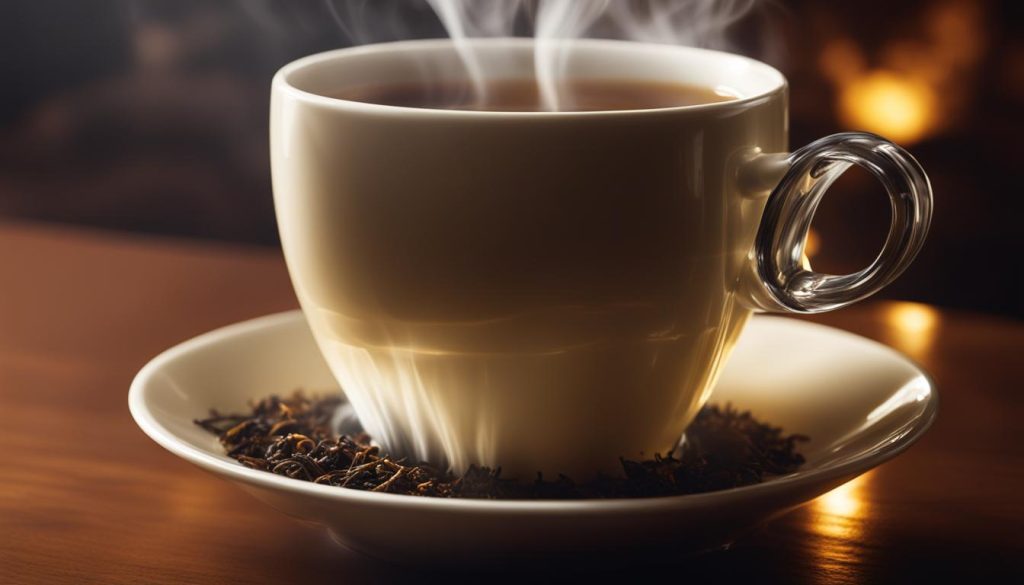
Tools and Techniques for Steeping Tea
When it comes to steeping tea, having the right tools and techniques can enhance your tea brewing experience. Whether you prefer loose leaf tea or cold-brewed tea, there are various tools available to help extract the rich flavors and aromas. Let’s explore some essential tea steeping tools and techniques that will elevate your tea-drinking experience.
Tea Steeping Tools:
For steeping loose leaf tea, the following tools are indispensable:
- Tea Scoop: A tea scoop is a small spoon-like tool used to measure and portion loose leaf tea accurately. It ensures that you add the perfect amount of tea for a flavorful brew.
- Tea Ball or Infuser: A tea ball or infuser is perfect for steeping loose leaf tea without the hassle of straining. It is a metal or silicone ball with small holes that allow the water to flow through while retaining the tea leaves.
- Cold-Brewing Jar: To prepare refreshing cold-brewed tea, a large mason jar is a must-have. The sizeable wide-mouthed jar allows for easy preparation and storage, as well as the infusion of flavors over time.
Steeping Techniques:
Now that you have the essential tools, let’s explore some popular tea steeping techniques:
- Hot Steeping: This traditional method of steeping involves adding hot water to your tea leaves and allowing them to infuse for the recommended time. The water temperature and steeping time may vary depending on the type of tea you’re brewing.
- Cold Steeping: Cold steeping, also known as cold brewing, is a slow and gentle process that allows the flavors of tea to infuse gradually. It involves steeping tea leaves in cold water for an extended period, typically overnight, resulting in a smooth and refreshing brew.
Experimenting with different tools and techniques can open up a world of possibilities for flavor combinations and brewing styles. With the right tools and the freedom to adjust steeping times and temperatures, you can customize your tea to suit your taste preferences.
| Tea Steeping Tools | Description |
|---|---|
| Tea Scoop | A small spoon-like tool used to measure and portion loose leaf tea accurately. |
| Tea Ball or Infuser | A metal or silicone ball with small holes for steeping loose leaf tea without straining. |
| Cold-Brewing Jar | A large mason jar perfect for preparing and storing cold-brewed tea. |
Importance of Quality Ingredients and Water
In order to enjoy the tastiest and healthiest cup of tea, it is crucial to start with quality ingredients and fresh, cold, and filtered water. Both the ingredients and water used in the steeping process greatly impact the flavor and overall experience of the tea.
Dried tea leaves have a long shelf life, but over time, they may lose some of their flavor, aroma, and health-promoting antioxidants. To ensure that your tea is as flavorful and beneficial as possible, it is recommended to use fresh ingredients. Fresh tea leaves or herbal ingredients can provide a more vibrant and robust flavor profile.
The quality of water used for brewing is equally important. Tap water, especially when high in minerals or treated with chlorine, can have a noticeable impact on the taste and aroma of the tea. Using filtered water helps to eliminate impurities and ensures a cleaner, refreshing taste.
When choosing the ingredients and water for your tea, consider the desired flavor and health benefits. Experimenting with different combinations can result in unique and delightful tea experiences.
Benefits of Fresh Ingredients:
- Enhanced flavor profile
- Retained aroma
- Increased health-promoting antioxidants
Advantages of Filtered Water:
- Cleaner and smoother taste
- Elimination of impurities
- Reduction in unwanted flavors or odors
To further understand the importance of quality ingredients and water, let us take a look at the following table:
| Factor | Quality Ingredients | Filtered Water |
|---|---|---|
| Effect on Tea Flavor | Enhances the flavor profile and aroma | Provides a cleaner and smoother taste |
| Impact on Health Benefits | Increases the presence of antioxidants | Ensures elimination of impurities |
| Overall Tea Experience | Delivers a more vibrant and robust tea experience | Contributes to a refreshing and enjoyable tea moment |
As you can see, both quality ingredients and filtered water play significant roles in enhancing the flavor, aroma, and health benefits of your tea. By using fresh ingredients and filtered water, you can create a truly delightful and satisfying tea experience.
Tea Brewing Tips and Accessories
When it comes to steeping tea, having the right accessories can make all the difference. While there are specialized tools available, you can also brew a perfect cup of tea with simple accessories that you already have in your kitchen.
Let’s start with the basics. A teacup, tea bag, and kettle are essential items for tea brewing. These are great for single servings and are convenient for everyday use. If you prefer loose leaf tea, a tea infuser or tea ball is a must-have. The infuser allows the leaves to expand and release their flavors, resulting in a more satisfying brew.
For those who enjoy brewing larger batches of tea, teapots are the way to go. There are various types of teapots available, each offering its own unique benefits. Porcelain teapots are popular for their ability to retain heat and showcase the tea’s delicate flavors. Glass teapots allow you to watch the tea leaves unfurl, adding an element of visual delight to your brewing experience. Earthenware teapots are known for their heat retention properties, making them perfect for longer steeping sessions. Stainless steel teapots are durable and practical, ideal for everyday use.
| Teapot Material | Advantages |
|---|---|
| Porcelain | Retains heat, showcases delicate flavors |
| Glass | Allows visual enjoyment, showcases unfurling tea leaves |
| Earthenware | Retains heat, great for longer steeping |
| Stainless Steel | Durable, practical for everyday use |
Another important factor to consider when brewing tea is water temperature. Each type of tea requires a specific water temperature for optimal flavor extraction. For example, black tea typically requires boiling water, while green tea is best brewed with water below boiling point. It’s essential to adjust the water temperature to ensure you extract the desired flavors and avoid any unpleasant bitterness.
Steeping time is equally crucial in achieving a perfect cup of tea. Different types of tea have different steeping times. For example, delicate white teas require a shorter steeping time, while robust black teas can handle a longer infusion. It’s essential to follow the recommended steeping times to extract the best flavors from your tea.
Basic Tea Steeping Guidelines
- Boil water and allow it to cool to the desired temperature based on the type of tea you are brewing.
- Add the appropriate amount of tea leaves or tea bags to your teapot or cup.
- Pour the water over the tea leaves and let it steep for the recommended time.
- Once the steeping time is complete, remove the tea leaves or tea bags to prevent oversteeping.
- Enjoy your perfectly brewed cup of tea!
Remember, experimenting with steeping time and water temperature can help you personalize your tea brewing process and discover your preferred flavors.
Now that you have the knowledge about tea brewing accessories and techniques, it’s time to embark on a tea brewing journey. Explore different flavors, variations, and combinations. With the right tools and a little creativity, you can elevate your tea experience and enjoy a delightful cup of tea every time.
Tea Steeping for Health and Wellness Benefits
Tea steeping offers numerous health benefits. True teas and herbal teas contain polyphenol antioxidants, vitamins, and other compounds that promote wellness. Different types of tea have various effects, such as energy-boosting for green tea, stress and anxiety relief for chamomile tea. Regular tea consumption has been associated with improved overall health and well-being.
The Power of Antioxidants in Tea
One of the key health benefits of tea is its high antioxidant content. Antioxidants help protect the body against free radicals, unstable molecules that can cause damage to cells and contribute to various health issues. Tea is particularly rich in catechins, a type of antioxidant that has been linked to a reduced risk of chronic diseases such as heart disease, cancer, and diabetes.
Vitamins and Minerals for Wellness
In addition to antioxidants, tea also provides essential vitamins and minerals that are important for overall health and wellness. Depending on the type of tea, it can be a good source of vitamins such as vitamin C, vitamin E, vitamin K, and B vitamins. These vitamins play crucial roles in supporting the immune system, promoting healthy skin, boosting energy levels, and maintaining a balanced mood.
Boosting Energy and Mental Alertness
Green tea, in particular, is known for its energizing properties. It contains a moderate amount of caffeine, which can help improve focus, concentration, and alertness. Green tea also contains an amino acid called L-theanine, which works synergistically with caffeine to provide a calm and sustained energy boost without the jitters or crashes often associated with coffee or energy drinks.
Stress Relief and Relaxation
For those seeking stress relief and relaxation, herbal teas can be a great choice. Chamomile tea, for example, is well-known for its calming effects and ability to promote better sleep. The act of steeping and sipping tea itself can also have a soothing and meditative effect, making it a popular choice for relaxation and stress relief.
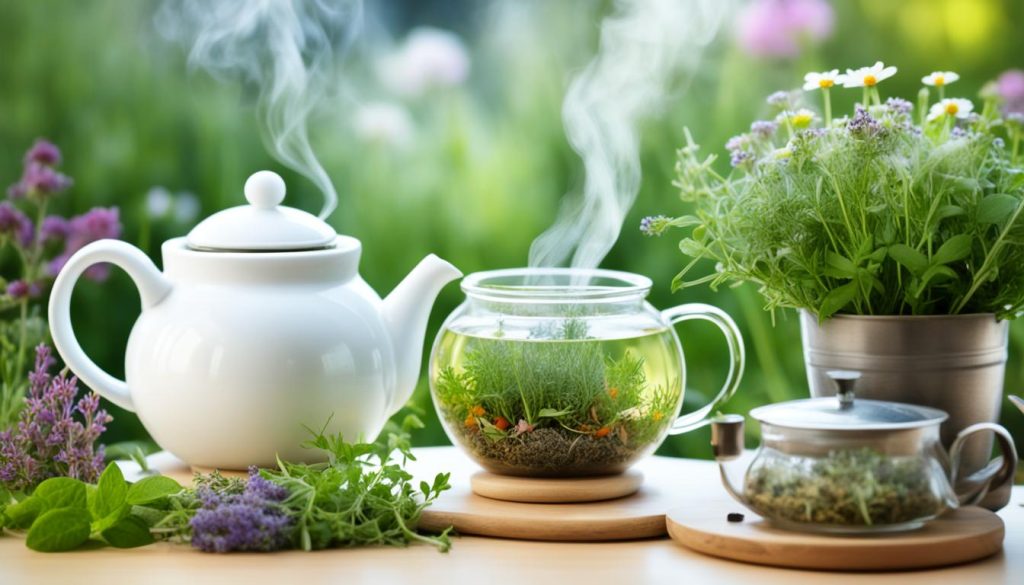
Overall, incorporating tea steeping into your daily routine can have a positive impact on your health and well-being. Whether you’re looking for a natural way to boost your energy levels, unwind after a long day, or reap the benefits of antioxidants and vitamins, tea can be a delicious and beneficial addition to your lifestyle.
| Type of Tea | Health Benefit |
|---|---|
| Green tea | Energy boosting, metabolism support |
| Chamomile tea | Stress relief, relaxation, better sleep |
| Black tea | Heart health, focus, mental alertness |
| Rooibos tea | Antioxidant-rich, skin health |
| Hibiscus tea | Blood pressure control, hydration |
Tea Steeping Techniques for Optimal Flavor
When it comes to steeping tea, timing is everything. Oversteeping can lead to an unpleasant bitterness that can overpower the delicate flavors of your brew. To ensure a perfect cup of tea, it’s important to follow the recommended steeping time for each type of tea.
However, if you accidentally oversteep your tea, don’t worry! There are ways to balance the bitterness and enhance the flavor. One option is to add natural sweeteners like honey or agave. These sweeteners not only add a touch of sweetness but also help counteract the bitterness.
For black teas, another effective method is to add a splash of milk or a slice of lemon. The creamy texture of milk can mellow out the brew, while the acidity of lemon can lighten the bitterness. These simple additions can transform a bitter cup of black tea into a smooth and enjoyable experience.
Remember, tea steeping is an art, and it’s all about personal preference. Feel free to experiment with different steeping times and techniques to find what suits your taste buds best. Whether you prefer a shorter steep for a lighter flavor or a longer steep for a stronger brew, the choice is yours. Don’t be afraid to get creative and discover the perfect steeping techniques that bring out the full potential of your tea.
Key Takeaways:
- Steep tea for the recommended time to avoid over-extraction and bitterness.
- If you oversteep your tea, balance the bitterness with natural sweeteners like honey or agave.
- For black teas, try adding a splash of milk or a slice of lemon to mellow out the brew.
- Experiment with steeping times and personal preferences to discover the perfect steeping techniques for optimal flavor.
| Steeping Technique | Effect |
|---|---|
| Steeping for the recommended time | Avoids over-extraction and bitterness |
| Adding natural sweeteners like honey or agave | Counteracts bitterness |
| Adding milk to black tea | Mellows out the brew |
| Adding a slice of lemon to black tea | Lightens the bitterness |
Endless Possibilities of Tea Enjoyment
When it comes to tea, everyone has their own preferences. Some of us crave a strong, bold brew that wakes us up in the morning, while others prefer a lighter, more delicate cup to unwind after a long day. The beauty of tea lies in its versatility – it can be enjoyed hot or cold, slowly sipped or quickly consumed.
With so many tea varieties, flavors, and brewing methods to explore, the possibilities are truly limitless. Whether you’re a fan of traditional black or green tea, or you prefer the aromatic blend of herbal infusions, you can create a unique tea experience that suits your personal taste.
For those who enjoy a strong cup of tea, try steeping your leaves or bags a bit longer to extract every bit of flavor. On the other hand, if you prefer a milder brew, steep for a shorter duration to avoid overpowering the subtle nuances of the tea. Don’t forget to experiment with different water temperatures and brewing times to find your perfect balance.
No matter your preference, tea can be enjoyed both hot and cold. A piping hot cup of tea can warm you up on a chilly day, while an iced tea can be a refreshing thirst-quencher during the summer months. Feel free to get creative with add-ins like fresh fruits, herbs, or a splash of your favorite sweetener to enhance the flavor.
